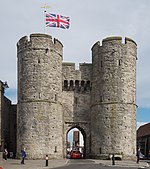Canterbury West railway station
1846 establishments in EnglandCanterburyDfT Category D stationsFormer South Eastern Railway (UK) stationsGrade II listed buildings in Kent ... and 4 more
Railway stations in Great Britain opened in 1846Railway stations in KentRailway stations served by SoutheasternUse British English from August 2015

Canterbury West railway station is a Grade II listed railway station, and the busier of the two stations in Canterbury in Kent, England. The station as well as all services are operated by Southeastern with both main line and high speed trains serving the station. The station and its line was built by the South Eastern Railway and opened in 1846. It was the first mainline station in Canterbury, while the later Canterbury East was built by the London, Chatham & Dover Railway. There was also a connection to the Canterbury and Whitstable Railway, the first railway in Kent, and later to the Elham Valley Railway; these have both since closed.
Excerpt from the Wikipedia article Canterbury West railway station (License: CC BY-SA 3.0, Authors, Images).Canterbury West railway station
Station Road West, Canterbury St. Mildred's
Geographical coordinates (GPS) Address Nearby Places Show on map
Geographical coordinates (GPS)
| Latitude | Longitude |
|---|---|
| N 51.284063888889 ° | E 1.0753805555556 ° |
Address
Station Road West
CT2 8AN Canterbury, St. Mildred's
England, United Kingdom
Open on Google Maps









